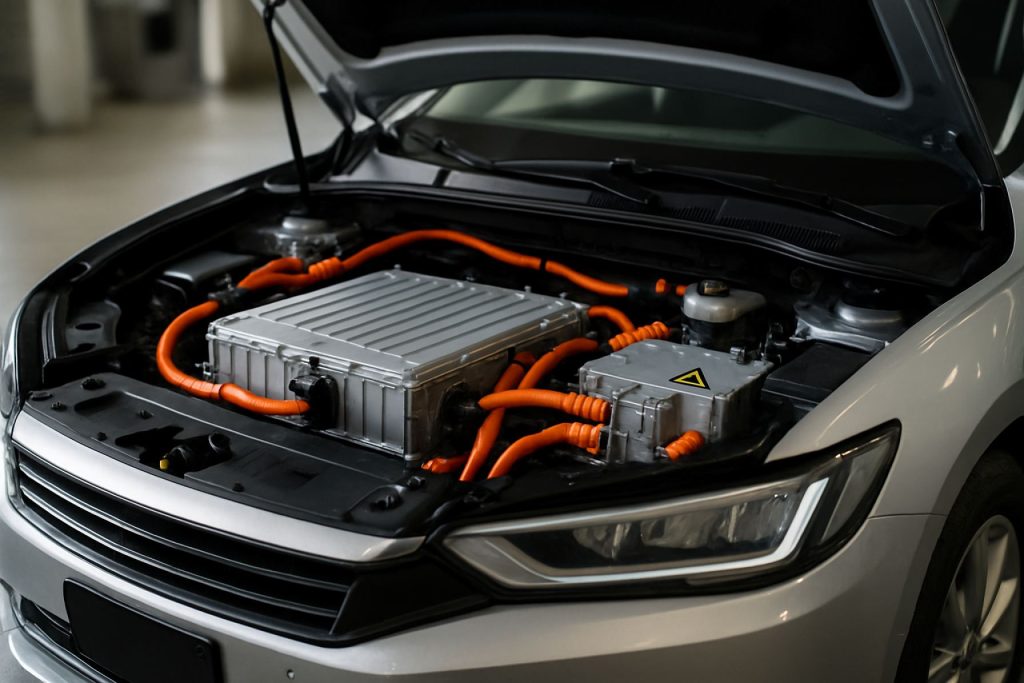
- Global electric vehicle (EV) battery production is set for explosive growth, with output expected to surpass 1,000 gigawatt hours annually by 2030.
- Lithium-ion technology remains central, but advances like lithium iron phosphate (LFP) batteries offer safer, more affordable options for everyday vehicles, while nickel-manganese-cobalt (NMC) chemistries cater to high-performance EVs.
- Solid-state battery innovation is emerging, promising up to 50% greater energy storage, faster charging, and enhanced safety, potentially revolutionizing EV markets.
- Battery industry leaders are prioritizing ethical mineral sourcing, closed-loop recycling, and regionalized supply chains to minimize environmental impacts and support circular economies.
- India is rapidly developing its battery manufacturing sector, propelled by strong policy support, positioning itself as a major global player.
- This battery boom is transforming clean transportation, climate strategy, and economic growth worldwide.
Beneath the hum of city streets, a quiet revolution gathers force — one defined not by roaring engines, but by the silent prowess of next-generation batteries. By 2030, global electric vehicle (EV) battery production is expected to reach unprecedented heights, redrawing the map of mobility and environmental impact.
Imagine gigafactories across continents humming day and night, from the icy tech corridors of Sweden’s Northvolt to sprawling complexes in China and South Korea. This surge in capacity is not a distant promise. Analysts project a 40 percent annual leap in global EV battery output — vaulting past the threshold of 1,000 gigawatt hours each year, a number almost unimaginable just a half-decade ago.
At the heart of this transformation, lithium-ion technology continues its reign — but it’s evolving at full tilt. Automakers are racing to adopt lithium iron phosphate (LFP) batteries, prized for safety and affordability. Even industry giants like Tesla are aggressively expanding LFP’s footprint across global fleets, recognizing its stability for everyday driving and mass-market cars. Meanwhile, the quest for power density propels nickel-manganese-cobalt (NMC) chemistries into the limelight, favored for high-performance vehicles demanding every ounce of range.
Yet, whispers in tech circles suggest the dawn of a new era: the solid-state battery. With pilot production lines running in Japan and stealthy progress by icons such as Toyota and Panasonic, this technology may rewrite the rulebook — offering energy storage up to 50 percent greater than today’s cells, faster charge times, and dramatically reduced fire risks. Picture a world where charging an EV feels as simple and speedy as filling up a gas tank.
But these innovations do more than extend your driving range — they shape geopolitics and the planet’s future. Leading producers are rethinking their supply chains, anchoring new factories closer to end markets and shrinking reliance on volatile global trade. Environmental stewardship is gaining teeth; companies are embracing closed-loop recycling systems and sourcing critical minerals like lithium and cobalt under stricter ethical frameworks. Firms such as Redwood Materials in the US or Umicore in Europe now extract valuable raw materials from spent batteries, cutting dependence on environmentally harmful mining practices and steering the industry toward circularity.
India, too, surges into the fray. Spurred by progressive government policies and robust incentives, a constellation of new battery plants is transforming the subcontinent into Asia’s next battery juggernaut. Ambitious targets under national initiatives promise to catalyze both clean transit and economic expansion.
The essential message: The coming battery boom is far more than a supply curve or an assembly line story. It’s about the democratization of clean transportation, the intersection of climate action and industry, and a race for technological preeminence that will reshape cities, economies, and lifestyles. If you’re waiting for the EV moment to arrive, rest assured: it’s thundering closer with every new battery rolling off the line.
Curious about the companies driving these breakthroughs? Explore some of the sector’s pioneers at Tesla and Panasonic.
The verdict: The race is on, and batteries are steering us into an era where clean, accessible, and high-performance electric mobility becomes the new baseline, rewriting what it means to hit the open road.
The Electrifying Future of EV Batteries: Industry Trends, Hacks, and Must-Know Facts for 2024 and Beyond
# Next-Gen EV Batteries: Breaking New Ground in Sustainability, Tech, and Market Dynamics
The silent revolution beneath our streets isn’t just about quieter roads—it’s about next-generation batteries sparking dramatic shifts in technology, climate impact, geopolitics, and the global economy. Here’s a deep dive into what the source article didn’t fully explore, paired with actionable insights, trusted references, and top battery trends poised to transform your drive and your world.
—
Unfeatured Facts & Industry Trends
1. Solid-State Battery Revolution: What You Need to Know
Solid-state batteries are the industry’s holy grail for energy storage. Beyond Japan’s pilot lines:
– Commercialization Timeline: Toyota, Panasonic, and QuantumScape anticipate commercial EVs with solid-state batteries as early as 2027–2028 ([source](https://www.bloomberg.com)).
– Key Advancements: Eliminates the flammable liquid electrolyte, enhancing safety and shelf life.
– Performance Edge: Promises energy density of up to 900 Wh/L (compare to current lithium-ion at ~700 Wh/L), potentially doubling EV range ([source](https://www.nature.com)).
2. Material Sourcing and Recycling: The Supply Chain Makeover
– Circular Supply Chain: Companies like Redwood Materials and Umicore are scaling advanced battery recycling to retrieve lithium, nickel, cobalt—reducing landfill waste and cutting harmful mining.
– Ethical Sourcing: Automakers are adopting global frameworks such as the Responsible Minerals Initiative to ensure cobalt and lithium traceability ([source](https://www.responsiblemineralsinitiative.org)).
– Regionalization: Localization of factories (e.g., Northvolt in Sweden, LG in the U.S.) decreases shipping emissions and supply chain delays.
3. Regional Leaders & Geopolitical Shifts
– China’s Dominance: Over 70% of global lithium-ion batteries are produced in China, fueled by CATL, BYD, and Tesla Shanghai’s Gigafactory ([source](https://www.iea.org)).
– The Rising Indian Market: India’s PLI scheme incentivizes domestic battery production, attracting $2+ billion in investments ([source](https://www.reuters.com)).
4. Life Hacks & How-To’s
How to Maximize Your EV Battery Life:
1. Charge Smart: Maintain battery charge between 20%-80%, avoiding frequent full charging.
2. Avoid Extreme Conditions: Park in shade; batteries degrade faster in extreme heat/cold.
3. Update Software: Automakers release battery management updates improving longevity.
—
Features, Pricing, and Tech Specs
Battery Types—A Quick Comparison
| Feature | LFP | NMC | Solid-State (Future) |
|—————–|———————————|———————————|—————————|
| Cost | Low | High | Initially Very High |
| Range | Moderate (200–300 miles) | High (300–400+ miles) | Very High (400+ miles) |
| Safety | Very Safe, Stable | Good but risk if damaged | Superior |
| Cycle Life | 2,000–5,000 cycles | 1,000–2,000 cycles | >5,000 cycles (expected) |
| Charging Speed | Good w/ latest tech | Fast | Ultra-fast |
| Brands | Tesla, BYD, CATL | Tesla, LG Chem, Samsung SDI | Toyota, QuantumScape |
Estimated Pricing (2024):
– LFP: ~$80–100/kWh
– NMC: ~$120–150/kWh
– Solid-State: $200+/kWh (pre-mass adoption)
—
Security, Sustainability, and Limitations
Pros & Cons Overview
Pros:
– Lower emissions compared to ICE vehicles
– Improving recycling reduces resource strain
– Enhanced safety (esp. LFP, solid-state)
– Declining cost per kWh (down 80% since 2010, [BNEF](https://about.bnef.com))
Cons & Limitations:
– Battery fire risk persists with some chemistries
– Cold weather can reduce range up to 30%
– Recycling infrastructure still scaling
– Ethical supply chain challenges remain, especially in cobalt mining
Sustainability Outlook
– Battery pack recycling may recapture >95% of valuable metals by 2030 ([source](https://www.umicore.com)).
– Closed-loop manufacturing could reduce EV carbon footprint by 50% over vehicle lifetime.
—
Most Pressing Reader Questions
Q: Are EV batteries truly sustainable long-term?
Answer: With closed-loop systems and stricter ethical sourcing, long-term sustainability is improving rapidly. Companies are expected to nearly eliminate mining waste by 2040.
Q: Will charging get faster?
Answer: Yes. New silicon anode and solid-state batteries promise sub-15 minute full charges within five years.
Q: Can I recycle my EV battery today?
Answer: In many regions, yes—via automaker take-back programs or specialized recyclers.
—
Insights, Predictions & Future Hacks
– By 2030, EVs could outsell gasoline cars in several markets (IEA).
– Battery storage will power homes and cities, not just cars—think resilient microgrids and backup power for renewables ([DOE](https://www.energy.gov)).
– New chemistries (sodium-ion, graphene) are under development to further reduce reliance on rare minerals.
—
Quick Tips & Immediate Action Steps
1. Futureproof your purchase: If buying an EV now, favor brands known for over-the-air battery updates and ethically sourced components.
2. Ask dealerships about battery recycling programs before buying.
3. Subscribe to industry updates via reliable sites like Tesla, Panasonic, and battery innovation leaders.
—
Conclusion: Act Now, Drive the Change
The battery revolution isn’t coming—it’s here, and accelerating. Whether you’re an eco-conscious driver, investor, or tech enthusiast, understanding next-gen batteries empowers you to make smarter, greener decisions today. Ready to plug into the future? Start by staying informed, supporting responsible manufacturers, and optimizing your own energy usage for a cleaner tomorrow.



